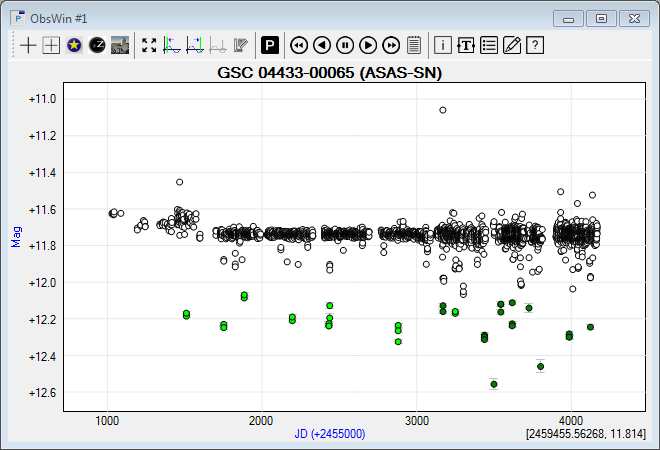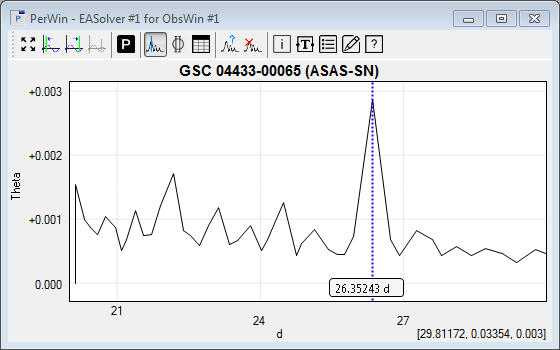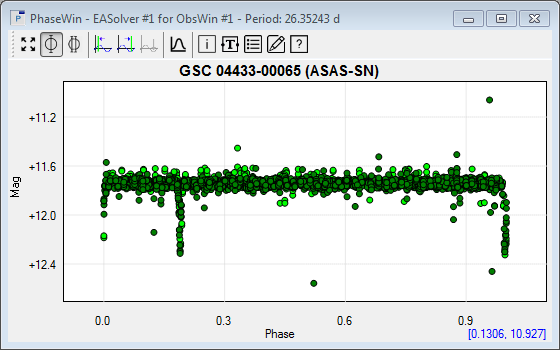- The EASolver method has been developed by Patrick Wils (Vereniging voor Sterrenkunde, Belgium) as a novel period search method that operates on photometric survey data of eclipsing Algol-type (EA) binaries. These survey data regularly are characterized by a majority of observations showing the variable in normal light, and very sparse data showing the variable in an eclipsing state. Note that EASolver requires at least three observations showing the star in faint state (close to or in eclipse), and you can only select one observation per faint state.
- Open the aligned ObsWin GSC 04433-00065 from previous section. EASolver will determine the orbital period, using only the faint-state observations. Instruct Peranso to only work with faint-state observations, by deactivating all other observations. To deactivate a group of observations in an Observations Window, hold the Shift button on the keyboard, and meanwhile click and hold the left mouse button. A rubberband rectangle appears. Release the left mouse button when the rectangle contains the observations of interest. Peranso will toggle the Use state (active/deactive) of all observations within the rubberband rectangle.

- Click the Period Determination button in the ObsWin toolbar and select the EASolver method. We select Days and Time and use a Range going from 20 to 30 days. If we use a range of 10 to 30 days, EASolver will find a dominant period near 10.36 days, which is incorrect. The correct period of 26.4 days is visible in the EASolver PerWin, but kind of hidden. This is an example where EASolver is less performant than EEBLS, but we have analysed light curves where the opposite is true. In general, when the number of 'low state' observations is small, EASolver yields better results than EEBLS.
- Click Apply to start the EASolver calculation. This creates a PerWin with a dominant period of 26.35243 +/- 0.39686 days, which corresponds very well with the value of 26.35150 days, mentioned by Sebastian Otero who used more observations for his analysis work.

- Before displaying the PhaseWin corresponding with the above period, we have to first activate all observations in the ObsWin. Click on the ObsWin and in the Observations window menu select Observation sets. In the drop down menu select Activate all.
- Then click the PhaseWin at Frequency Cursor value button
 in the PerWin toolbar to display a Phase Window showing the observations folded over the above period. Switch to Single Phase View. You will again see the primary eclipse in the GSC 04433-00065 light curve, centered near Phase 0.0, and the secondary eclipse near Phase 0.19. in the PerWin toolbar to display a Phase Window showing the observations folded over the above period. Switch to Single Phase View. You will again see the primary eclipse in the GSC 04433-00065 light curve, centered near Phase 0.0, and the secondary eclipse near Phase 0.19.

Additional exercise
This tutorial contains another eclipsing binary light curve. Open the file V0493 Sct which shows a total of 294 ASAS-31 observations. Only 5 of them show the variable in faint state. These observations were kindly provided by Sebastian Otero.
Using visual inspection it is difficult to make a good initial guess of the orbital period of V0493 Sct. We will therefore use a search range from 10 to 100 days. Using EEBLS, we find an oribtal period of 30.803 days. The PhaseWin very clearly shows the primary and secondary eclipse phases. Using EASolver, we find an oribtal period of 30.810 days. Both values are in good agreement with the value of 30.811 days published in the AAVSO VSX index.
(1) Pojmanski G., The All Sky Automated Survey, Acta Astronomica, 52, 397, 2002
|